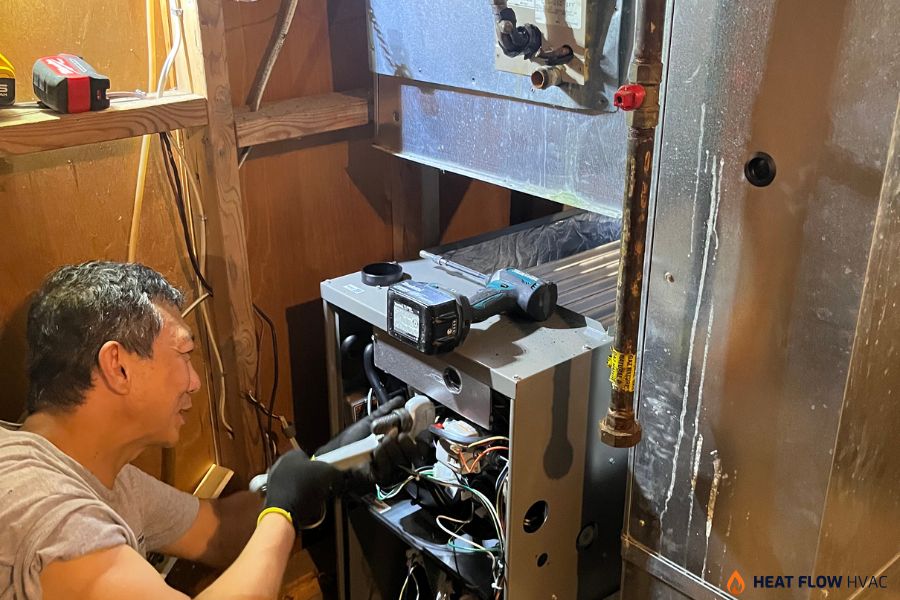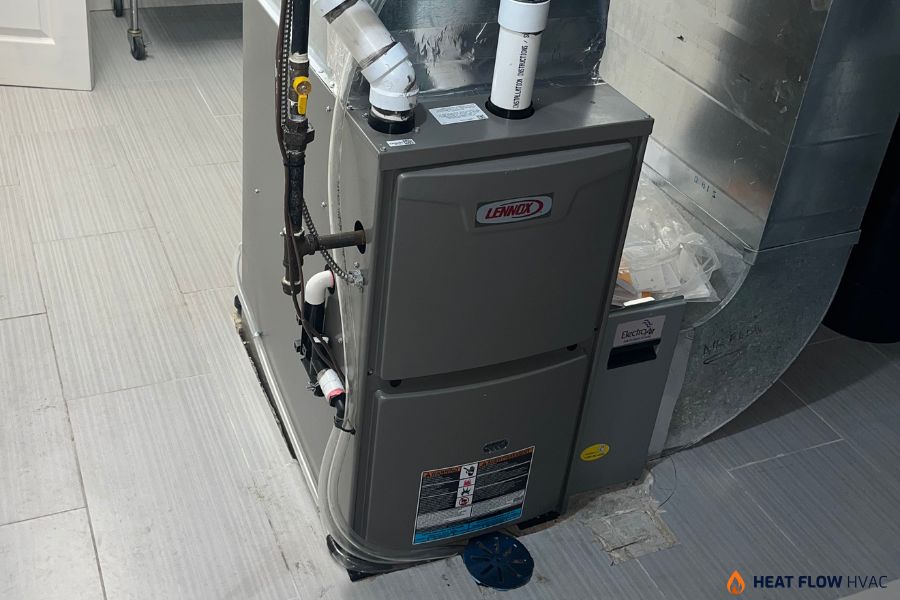If you’re struggling to decide between a gas furnace and a heat pump for your Ontario home, you’re not alone. The same question is being asked by homeowners in Mississauga’s condos, Hamilton’s detached homes, and Oakville’s townhouses as energy costs rise and new technology alters the landscape. The answer depends on the kind of home you have, where it is, how much it costs, and how convenient it is. In this overview, we’ll break down the practical differences between furnace and heat pump systems to help you make an informed choice.
How a Furnace and a Heat Pump Work
Heat is produced by burning natural gas in a gas furnace and then distributed through your ductwork. For a long time, Ontario’s heating system has been a reliable, trustworthy system.
Heat isn’t generated by a heat pump. Instead, even in cold weather, it transfers heat from the outside air into your house. Like an air conditioner, it reverses direction in the summer to cool your house. Nearly all of southern Ontario’s winter temperatures are covered by modern cold-climate heat pumps, which are designed to function smoothly down to -25°C or lower.
Performance in Ontario Winters: Is a Heat Pump Sufficient?
One of the biggest concerns we hear is, “Will a heat pump keep my home warm during an Ontario winter?” The short answer is yes for most homes.
In cities like Burlington, Toronto, and Guelph, average January lows range from –8°C to –12°C. Even during cold snaps that dip to –20°C, today’s cold-climate heat pumps continue to deliver heat. We’ve installed them successfully in:
- Detached homes with or without existing ductwork
- Semi-detached houses where space for outdoor units is limited
- Townhouses in newer developments like those in Vaughan or Milton
- Condos and apartments without gas lines, especially in downtown cores
That said, if you live in a remote part of Northern Ontario where temperatures stay below –25°C for extended periods, a gas furnace or a hybrid system may still be the more practical choice.

Home Type Differences in the Furnace vs. Heat Pump Installation
The layout of your house significantly impacts what kind of system seems to work:
- Gas lines and ductwork are common in older detached homes, which makes upgrading a furnace simple.
- Heat pumps function strongest in recently built or entirely electrical homes, especially those on Ontario’s clean electricity grid.
- Ductless mini-splits are advantageous for townhouses and semi-detached homes because they circumvent the inefficiencies of shared or confined duct systems.
- Heat pumps provide comfortable targeted warmth with a simple heat pump upgrade, making them ideal for condos without gas access.
Furnace vs. Heat Pump: What Commonly Works in Ontario Homes
Most online comparisons treat all homes the same. But in Ontario, your choice between a furnace and a heat pump depends heavily on your home’s age, layout, fuel access, and even your street. After installing hundreds of systems from downtown condos to rural acreages, we’ve learned that the “best” system isn’t about technology alone, it’s about fit.
Here’s how the decision plays out in real neighborhoods we serve:
Home Type & Location | Typical Fuel Access | Best System | Why It Works |
|---|---|---|---|
| 1950s–1980s detached bungalow (Hamilton, Burlington, Etobicoke) | Gas line + existing ductwork | High-efficiency gas furnace | Ducts are often leaky but usable; gas is already paid for; furnace handles deep cold reliably. |
| 2015–2024 townhouse (Vaughan, Oakville, Milton) | All-electric, no gas | Ductless mini-split heat pump | No gas option; shared walls demand quiet operation; zoning solves upstairs/downstairs imbalance. |
| Condo (Mississauga City Centre, Toronto core) | Electric only, balcony access | Single-zone ductless heat pump | Minimal installation impact; replaces baseboard heat; qualifies for full Greener Homes Grant. |
| New custom build (Burlington escarpment, Oakville lakeshore) | Choice at build stage | Ducted cold-climate heat pump + backup | Designed for efficiency; future-proofs against carbon pricing; pairs with smart thermostats and solar. |
| Older semi-detached (Kitchener, Guelph, Stoney Creek) | Gas available, but poor insulation | Heat pump + air sealing upgrade | Avoids wasting gas on leaky envelope; heat pump + insulation = lower bills than furnace alone. |
These recommendations come from actual installations we’ve completed and the feedback we get months later when customers tell us, “We’re finally comfortable,” or “Our January bill was half what it used to be.”
If your home doesn’t fit neatly into one of these categories, that’s okay. Every house has a unique approach. The key is matching your system to your reality, not a brochure.

Cost Factors When Installing Heat Pump vs Upgrading Gas Furnace
Cost is often the deciding factor. Here’s what Ontario homeowners typically pay for installation:
System | Average Installed Cost (2025) | Best For |
|---|---|---|
| High-Efficiency Gas Furnace (95%+ AFUE) | $4,500 – $7,000 | Homes with existing gas lines; large detached houses |
| Ducted Heat Pump (Cold-Climate, 18+ SEER) | $7,000 – $11,000 | All-electric homes; new builds; eco-conscious owners |
| Ductless Mini-Split (1–3 zones) | $5,000 – $9,000 | Townhouses, additions, condos, or homes without ducts |
If your home doesn’t have a gas line, installing one can cost $2,000 to $5,000 or more, making a heat pump far more economical upfront.
Monthly Operating Costs: Gas vs. Electricity
Natural gas is cheaper per unit than electricity, but heat pumps are so efficient that they often cost less to run overall. For a typical 2,000 sq. ft. home in Mississauga, a high-efficiency furnace might cost $120 to $160 per month in January. The same home with a cold-climate heat pump could spend $100 to $140, especially if you use Time-of-Use electricity rates wisely.
In well-insulated homes or milder regions like Niagara-on-the-Lake, heat pumps can reduce heating costs by 30% to 50% compared to older furnaces or electric baseboards.
Rebates Make Heat Pumps More Affordable
This is where the furnace vs. heat pump comparison shifts dramatically. Ontario homeowners can access significant incentives for heat pumps:
| Incentive | Amount | Eligibility |
|---|---|---|
| Canada Greener Homes Grant | Up to $5,000 | Requires energy audit; applies to heat pump installation |
| Enbridge Gas Furnace Rebate | Up to $1,000 | Only for gas furnaces; requires existing gas service |
| Save on Energy Smart Thermostat Rebate | $75–$100 | Available with either system |
The Canada Greener Homes Grant alone can cover a large portion of a heat pump’s upfront cost, something gas furnaces simply don’t qualify for at this level.
Deciding Factors in Choosing the HVAC Service
Beyond cost, consider how each system affects your daily comfort:
- If your home struggles with humidity in summer, modern heat pumps offer superior dehumidification compared to older AC-and-furnace combos. Discover how humidity affects your cooling system.
- If you have hot and cold spots, common in multi-level townhouses or older detached homes, a ductless heat pump with zoning lets you heat the basement separately from upstairs bedrooms.
- A heat pump replaces both your furnace and your air conditioner, simplifying maintenance and reducing the chance of summer breakdowns like those described in our guide on AC compressor repair vs. replacement.
The Hybrid Option: Best of Both Worlds
For many Ontario homeowners, a hybrid system offers the ideal balance: a heat pump handles heating during mild fall and spring days, and a gas furnace kicks in during deep cold snaps. This setup is especially effective in regions like Barrie or Kitchener, where winter temperatures fluctuate widely.
Environmental Impact: Which Is Cleaner?
Ontario’s electricity grid is over 90% emissions-free, thanks to nuclear and hydro power. That means running a heat pump produces far fewer greenhouse gases than burning natural gas. If reducing your carbon footprint matters to you, a heat pump aligns better with long-term environmental goals.

When a Gas Furnace Installation Is Best Suited
A gas furnace may be the better choice if:
- You already have a high-efficiency furnace less than 8 years old.
- Your home is large (3,000+ sq. ft.) and poorly insulated, making electric heating too costly.
- You’re on a tight budget and can’t afford the higher upfront cost of a heat pump, even with rebates.
- You live in an area with frequent winter power outages and no battery backup.
If you want to learn more about how to choose the right furnace. We walk you through sizing, efficiency ratings like AFUE, and how to match a furnace to your home’s layout and insulation, whether you’re in a drafty century home in Hamilton or a tightly sealed townhouse in Oakville. You’ll also learn how to avoid common mistakes that lead to uneven heating and higher gas bills.
The HVAC Installation Depends on Your Home
The “best” system isn’t universal. However, this is how we assist our clients in making a decision:
- A cold-climate heat pump is probably your best option if you want reduced long-term costs, environmental advantages, and year-round comfort, and if you are eligible for rebates.
- A high-efficiency furnace is still a good option if you value dependability in extremely cold temperatures and have gas infrastructure already.
Proper installation and sizing are essential in either case. Fuel is wasted in an oversized furnace. In cold weather, a heat pump that is too small struggles. Whether you live in a luxury townhouse in Vaughan or a bungalow in Brantford, we always do a thorough load calculation before suggesting a system.
We provide free in-home evaluations throughout the Greater Toronto Area, Hamilton, Niagara, and beyond if you’re prepared to consider your options. Instead of giving you general estimates, we’ll help you compare actual figures for your particular house.
The best system is ultimately the one that keeps your family comfortable, your bills consistent, and your house functioning properly for many years to come, not the cheapest or greenest one.